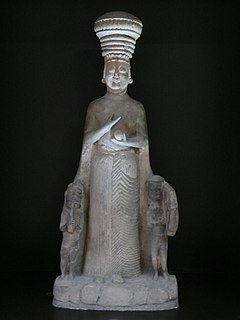Antilochus (Ancient Greek : Ἀντίλοχος) was a historian of ancient Greece who wrote an account of the Greek philosophers from the time of Pythagoras to the death of Epicurus, whose system he himself adopted. [1] He seems to be the same as the "Antilogus" mentioned by Dionysius of Halicarnassus. [2] [3] Theodoret quotes an Antilochus as his authority for placing the tomb of Cecrops I on the acropolis of Athens, [4] but as Clement of Alexandria [5] and Arnobius [6] refer for the same fact to a writer of the name of "Antiochus", there may possibly be an error in Theodoret.

Ancient Greece was a civilization belonging to a period of Greek history from the Greek Dark Ages of the 12th–9th centuries BC to the end of antiquity. Immediately following this period was the beginning of the Early Middle Ages and the Byzantine era. Roughly three centuries after the Late Bronze Age collapse of Mycenaean Greece, Greek urban poleis began to form in the 8th century BC, ushering in the Archaic period and colonization of the Mediterranean Basin. This was followed by the period of Classical Greece, an era that began with the Greco-Persian Wars, lasting from the 5th to 4th centuries BC. Due to the conquests by Alexander the Great of Macedon, Hellenistic civilization flourished from Central Asia to the western end of the Mediterranean Sea. The Hellenistic period came to an end with the conquests and annexations of the eastern Mediterranean world by the Roman Republic, which established the Roman province of Macedonia in Roman Greece, and later the province of Achaea during the Roman Empire.

Pythagoras of Samos was an ancient Ionian Greek philosopher and the eponymous founder of Pythagoreanism. His political and religious teachings were well known in Magna Graecia and influenced the philosophies of Plato, Aristotle, and, through them, Western philosophy. Knowledge of his life is clouded by legend, but he appears to have been the son of Mnesarchus, a seal engraver on the island of Samos. Modern scholars disagree regarding Pythagoras's education and influences, but they do agree that, around 530 BC, he travelled to Croton, where he founded a school in which initiates were sworn to secrecy and lived a communal, ascetic lifestyle. This lifestyle entailed a number of dietary prohibitions, traditionally said to have included vegetarianism, although modern scholars doubt that he ever advocated for complete vegetarianism.

Epicurus was an ancient Greek philosopher who founded a highly influential school of philosophy now called Epicureanism. He was born on the Greek island of Samos to Athenian parents. Influenced by Democritus, Aristotle, and possibly the Cynics, he turned against the Platonism of his day and established his own school, known as "the Garden", in Athens. He and his followers were known for eating simple meals and discussing a wide range of philosophical subjects, and he openly allowed women to join the school as a matter of policy. An extremely prolific writer, he is said to have originally written over 300 works on various subjects, but the vast majority of these writings have been lost. Only three letters written by him—the Letters to Menoeceus, Pythocles, and Herodotus—and two collections of quotes—the Principle Doctrines and the Vatican Sayings—have survived intact, along with a few fragments and quotations of his other writings. His teachings are better recorded in the writings of later authors, including the Roman poet Lucretius, the philosopher Philodemus, the philosopher Sextus Empiricus, and the biographer Diogenes Laërtius.



